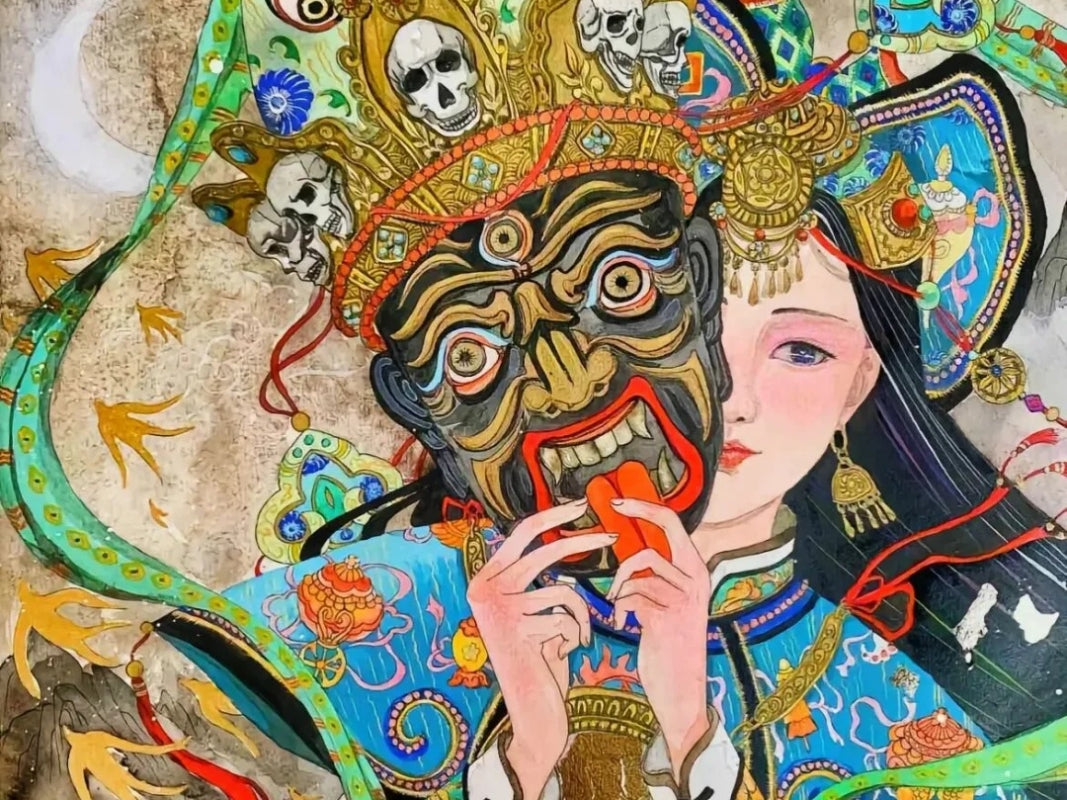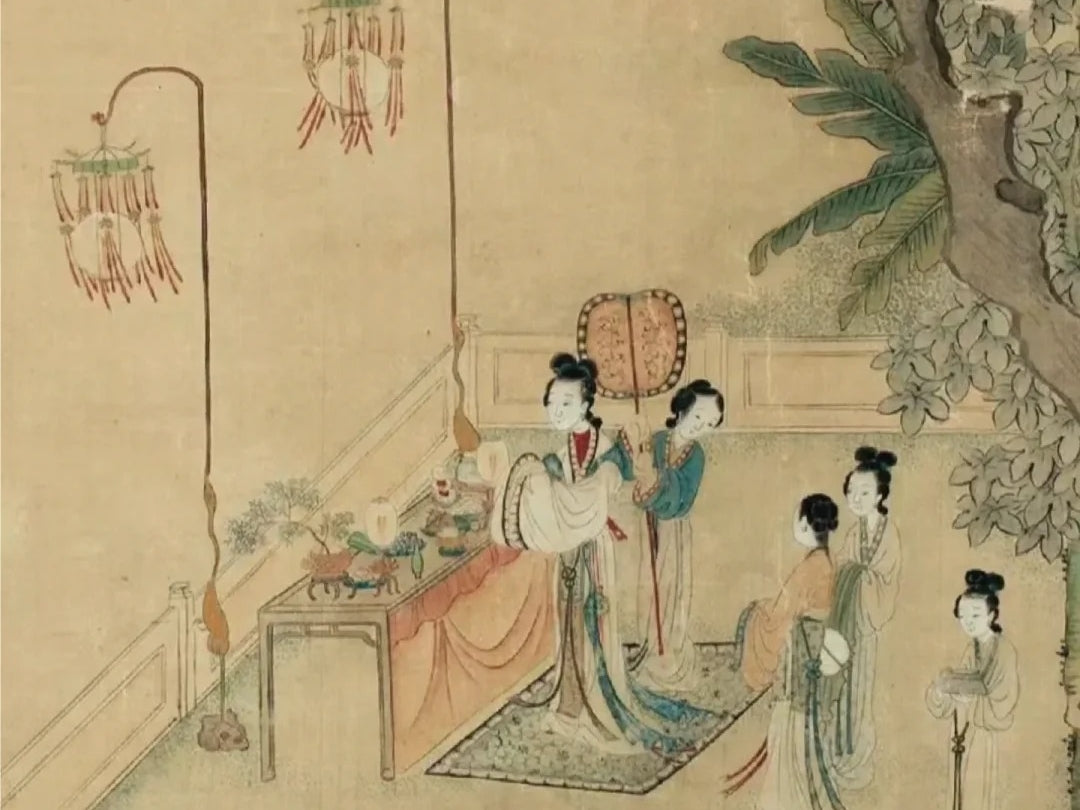What is a Thangka?
Thangka (唐卡), transliterated from Tibetan, refers to the traditional Tibetan scroll painting that is a distinctive form of visual art deeply rooted in Tibetan culture. It is often created on cloth, silk, or paper, and features vibrant colors and intricate designs. With strong ties to Tibetan Buddhism, Thangkas serve as essential tools for meditation and rituals. Devotees believe that worshipping a Thangka brings blessings, while gazing upon it can inspire spiritual contemplation.
The content of Thangkas is vast, encompassing themes from Tibetan religion, history, politics, culture, social life, and ethnic customs, earning it the title of the "Encyclopedia of Tibetan Culture."

The creation of a traditional Thangka is an intricate and sacred process. Before beginning, the artist must consult a living Buddha(Tulku), select an auspicious day, bathe, and purify themselves. The painting process involves preparing the canvas, outlining the design, coloring, meticulously detailing the artwork, and finally, blessing the Thangka with rituals. The use of pure natural pigments ensures the artwork remains vibrant for centuries.
A Thangka's composition is a cohesive whole, with various elements such as lotus seats, halos, clouds, floral patterns, and other decorative motifs connecting the figures. Especially in those influenced by Han Chinese painting, golden landscapes and exotic flora are common background themes, all bearing religious significance. For example, when depicting the Pure Land of Buddha, elements like celestial palaces, jeweled lotus ponds, and divine birds are essential. The artwork may also feature auspicious symbols like the Seven Treasures and the Eight Auspicious Signs, often presented as offerings to the main deity.

Thangka art has evolved with modern techniques, but its unique characteristics continue to captivate people, earning it the title of a "national treasure." Creating a Thangka can take months or even years, with each step demanding patience and skill. The use of precious mineral pigments such as gold, silver, pearls, and gemstones ensures the artwork retains its brilliance over time, often appearing as radiant and fresh as the day it was completed, even after centuries.


What is a Tibetan Thangka Buddha Pendant(Gawu Box) ?
Unlike Thangkas, Gawu boxes are more suited for daily wear. "Gawu" is a transliteration from Tibetan, referring to a protective amulet box. Typically, it contains small Buddha statues, relics, sacred pills, the hair of living Buddhas, or other blessed objects like sacred scriptures. Both Tibetan and Han Chinese Buddhism widely promote wearing Gawu boxes as a form of protection and spiritual support, often embedding sacred texts like the Shurangama Mantra (楞严咒) inside.
Gawu boxes are beautiful, intricately designed small treasure boxes, primarily handcrafted. The front often features various sacred images, while the back typically bears a stamp of the syllable a Vajra symbol, representing indestructible strength and wisdom, making it a highly revered and cherished item for blessings, gifting, and personal wear.

Materials for Gawu boxes include gold, silver, copper, and stainless steel, with different shapes and sizes, making them comfortable and convenient to wear around the neck or chest. Wearing a Gawu box symbolizes protection and serves as a decorative accessory, making it a popular choice among Tibetans.

The Origin of Gawu Boxes
Legend has it that in the winter of 1757, the Nyingma master, Jigme Lingpa, received a Gawu box from a Dakini after a long period of spiritual practice. According to his biography, the Gawu box was intricately crafted, emitting a scent of camphor, and contained five rolls of yellow paper inscribed with the teachings of the "Terma" (伏藏文) lineage. Such descriptions of Gawu boxes are numerous in Tibetan literature.
For the people of the "Himalaya-Tibet" region, the Gawu box symbolizes both status and spiritual practice, serving as a portable shrine that holds the essence of their faith. In the Tibetan context, "Gawu" means "small box," also known as "sealed box" or "sacred box." These terms highlight the Gawu box's form and its sacred significance. While its origins are debated, Gawu boxes are considered protective amulets safeguarding both soul and body.
The materials and decorations of Gawu boxes carry specific sacred meanings, such as turquoise used as a "soul stone" and common symbols like the swastika. During the Tubo Dynasty (629–846 AD), similar ornaments became symbols of power and rank. With the introduction of Buddhism, Gawu boxes were infused with Buddhist elements. The "Five Teachings of Padmasambhava" (五部遗教) mentions Tibetan emperors offering Gawu boxes to Guru Rinpoche.


Wearing a Gawu Box
As a cultural phenomenon, Gawu boxes have accompanied the rise of Tibetan Buddhism for over a thousand years. Devout Tibetans like to carry Buddha images with them to receive blessings from the deities and to remind themselves to practice virtuous deeds and strive for spiritual progress.
For some practitioners, carrying a Buddha image serves as an object of veneration—one of the reasons Thangkas (two-dimensional Buddha images) emerged. With the creation of moldable Buddha figures, Tibetans increasingly preferred carrying these small three-dimensional statues. However, considering it disrespectful to have Buddha images directly touch the body, the Gawu box was created, thus establishing its origin.
As the name suggests, the Gawu box is a protective talisman meant to safeguard against disasters and bring peace. Similar to wearing a jade Guanyin pendant, there are specific practices to observe when wearing a Gawu box to ensure its effectiveness.
When first wearing or placing a blessed Gawu box, it is essential to choose an auspicious time—between 7:00 and 9:00 a.m., considered the most favorable time of day, often called the "Dragon's Rising Hour." Those born under the sign of the dog should adjust the time accordingly due to astrological conflicts. When wearing the Gawu box, maintain a sincere attitude, wash your face and hands, and silently recite your wishes.
Avoid direct contact between the Gawu box and your skin; wear it over clothing. When entering non-sacred places such as bathrooms or during intimate activities, remove the Gawu box.
It is also advisable not to wear the Gawu box while bathing, as the water can demagnetize the blessed box, diminishing its spiritual potency and possibly causing it to slip and break, negatively impacting your recent fortune. If you are not wearing the Gawu box for an extended period, store it wrapped in a clean cloth in a high place or return it to a temple. Never leave it carelessly around.
If a blessed Gawu box becomes damaged, it is considered a positive sign, indicating it has absorbed misfortune on your behalf. If the Gawu box can no longer be worn, wrap it in a red cloth or paper and take it to a temple or bury it under a tree or flower bed. You may also wrap it in a red cloth and leave it at a crossroads to disperse negative energy or place it in a temple's incense collection area.
Choosing the Right Buddha Pendant Necklace
When selecting a QiLing Aura pendant necklace, understanding the meanings behind the images of the gods can help you find the perfect piece to enhance your spiritual journey. For instance:
-
Amitabha Buddha: Embodies infinite light, wisdom, and compassion, guiding souls to the Pure Land.
- Acala (Fudo Myo-o): A protector deity representing unwavering courage and determination.
- Vairocana (Great Sun Tathagata): Symbolizes the cosmic Buddha, the source of all light and wisdom, and the ultimate truth of the cosmos. Ideal for those dedicated to spiritual growth and enlightenment.
- Mahasthamaprapta: Illuminates with wisdom, helping beings break free from the cycle of reincarnation.
- Samantabhadra: Represents great vows and endless virtue, inspiring practitioners to benefit all beings.
- Four-Armed Avalokiteshvara: Embodies boundless compassion, offering swift assistance to those in need.
- Manjushri Bodhisattva: The embodiment of wisdom, holding a sword to cut through ignorance and a scroll representing the Perfection of Wisdom. Perfect for individuals seeking clarity, knowledge, and spiritual enlightenment.
- Akasagarbha: Bestows wisdom and prosperity, making it ideal for those seeking success in studies and career.
- Yellow Jambhala: A deity of wealth, eliminating poverty and bringing prosperity.
- Green Tara: A manifestation of Avalokiteshvara, known for swift action in relieving suffering.
- Medicine Buddha: Heals physical and mental ailments, promoting health and longevity.
- Nine-Tailed Fox: A mystical figure representing transformation, prosperity, and protection, guiding individuals toward positive change and success.
- The Fifth Lord (五爷): Revered in Tibetan Buddhism, he is the compassionate fifth son of the Dragon King and the God of Wealth, overseeing the distribution of earthly riches and bringing prosperity to those who seek his blessings.
- Zakiram(Zhaqi Lhamo扎基拉姆):Zhaqi Lhamo is a significant goddess in Tibetan Buddhism, revered as a protector deity and one of the most well-known female guardian deities in the tradition. She is considered an embodiment of the "Goddess of Auspiciousness" and is widely recognized as a symbol of good fortune and protection. According to legend, she has saved many lives and passed on the teachings of Buddhism to countless followers. As a result, Zhaqi Lhamo is also regarded as a symbol of wealth and happiness.
By understanding the symbolism behind each god, you can choose a QiLing Aura Thangka Buddha Pendant Necklace that resonates with your personal spiritual needs and aspirations, allowing you to carry these sacred blessings with you every day.




1 comment
Anonymous
It’s so surprising, I love Tibetan culture!
It’s so surprising, I love Tibetan culture!